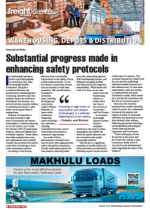In the fast-paced world of logistics and warehousing, technology is propelling change at an unprecedented rate. Robotics, inventory management systems, f leet management solutions, and the Internet of Things (IoT) are driving transformative shifts in the industry. Even on local shores, says Michael Henning, sales manager at Easy Clear, large warehouses are adopting advanced technologies, with robotic systems taking centre stage in cargo handling and order fulfilment within the fast-moving consumer goods and e-commerce sectors. “This surge in digital automation is enhancing efficiency and safety by reducing human involvement in hazardous tasks,” he told Freight News.The integration of robotics into warehouse operations is one of the most noticeable and impactful advancements in recent years. Robots equipped with specialised algorithms and sensors are being used for various tasks, such as picking, packing, and transporting goods. These robotic assistants are exceptionally efficient, capable of working around the clock without fatigue, and are highly precise, reducing errors in order fulfilment.“We are increasingly seeing warehouses employing robotic bins that autonomously pick and pack cargo, significantly expediting the shipping process. This has proven especially valuable in the e-commerce industry, where the demand for rapid order fulfilment continues to rise,” said Henning.Automation and its potential impact on employment have been topics of global concern for several years, and South Africa is no exception. While automation promises increased efficiency and productivity, there is a legitimate concern that it could lead to job displacement in a country with high unemployment rates. This debate over automation in South Africa is complex, with both advantages and disadvantages to consider"The perception of job losses is just one of the challenges," said Henning. "The cost of adoption looms as another significant concern frequently raised. However, it's important to note that when managed effectively, labour can undergo upskilling, and the expenses associated with technology adoption can be offset by the savings derived from heightened efficiencies. "Automating repetitive tasks, for example, frees human workers to concentrate on more intricate responsibilities that also boost overall productivity."Optimisation, says Henning, leads to greater efficiencies, which, in turn, can result in a significant return on investment (ROI) through savings and reduced costs. This principle is at the core of business strategy and continuous improvement efforts in the warehousing sector.Asked about artificial intelligence in the local warehousing and depot environment, Henning said it was still early days. "If we were to liken AI to human development, it's safe to say that AI is currently in its adolescence. We have much to explore and impart in this field. However, considering the repetitive nature of warehousing tasks and the capability to digitise processes, AI and robotics can swiftly acquire and apply knowledge."

